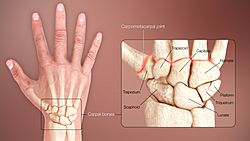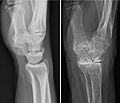Wrist facts for kids
Quick facts for kids Wrist |
|
|---|---|
 |
|
| A human showing the wrist in the centre. | |
 |
|
| The carpal bones, sometimes included in the definition of the wrist. | |
| Latin | articulatio radiocarpalis |
The wrist is a very important joint in your body. It's the flexible area where your hand connects to your forearm. This amazing part of your arm helps you do many everyday things. It allows your hand to move in many directions, like waving hello or typing on a keyboard.
Contents
Your Amazing Wrist Joint
Your wrist is not just one simple joint. It's actually a complex area made up of several bones, ligaments, and tendons. This special design allows for a wide range of motion. It helps you grip things, twist your hand, and move your fingers with precision.
What Makes Up Your Wrist?
The wrist area includes eight small bones called carpal bones. These bones are arranged in two rows. They fit together like puzzle pieces. Above them are two long bones from your forearm: the radius and the ulna. The radius is the main forearm bone that connects directly to the carpal bones. The ulna is the other forearm bone.
Bones of the Wrist
- Radius: This is the larger bone in your forearm, on the thumb side. It connects directly to most of your carpal bones.
- Ulna: This is the smaller bone in your forearm, on the pinky finger side. It connects to the wrist through a special disc.
- Carpal Bones: There are eight small carpal bones. They are arranged in two rows of four bones each. These bones are:
- Proximal row (closer to your arm): Scaphoid, Lunate, Triquetrum, and Pisiform.
- Distal row (closer to your hand): Trapezium, Trapezoid, Capitate, and Hamate.
These small bones work together. They allow your wrist to be strong and flexible.
Important Wrist Structures
Besides the bones, your wrist has other key parts:
- Carpal Tunnel: This is a narrow passageway in your wrist. It's formed by bones and a strong band of tissue. Many tendons and a main nerve (the median nerve) pass through it.
- Anatomical Snuff Box: This is a small, triangular hollow area. You can see it on the back of your hand, near your thumb. It becomes visible when you extend your thumb.
- Flexor Retinaculum: This is a strong band of tissue. It holds the tendons that bend your fingers in place. It forms the roof of the carpal tunnel.
- Extensor Retinaculum: This is another strong band of tissue. It holds the tendons that straighten your fingers and wrist in place.
How Your Wrist Moves
Your wrist can move in many directions. These movements are essential for daily activities:
- Bending (Flexion): Moving your hand down, towards your forearm.
- Straightening (Extension): Moving your hand up, away from your forearm.
- Side-to-Side (Radial and Ulnar Deviation): Moving your hand towards your thumb (radial) or towards your pinky finger (ulnar).
- Circular Movements (Circumduction): A combination of all these movements, allowing your hand to make a circle.
These movements are possible because of the way the bones fit together. Strong bands of tissue called ligaments connect the bones. Tendons connect muscles in your forearm to the bones in your hand and fingers.
Keeping Your Wrist Healthy
Your wrists are used constantly throughout the day. It's important to take care of them.
- Warm-up: Before sports or activities, gently stretch your wrists.
- Proper Form: When lifting or exercising, use correct form. This prevents strain.
- Rest: If your wrists feel tired or sore, give them a break.
- Ergonomics: When using computers, make sure your wrists are in a neutral position. This means not bent too far up or down.
Sometimes, wrists can get injured. Common problems include sprains, fractures, or conditions like carpal tunnel syndrome. If you ever feel pain or discomfort in your wrist, it's a good idea to tell a grown-up. A doctor can help figure out what's wrong and how to make it better.
Images for kids
-
Projectional radiograph of a normal wrist (left image) and one with a dorsal tilt due to wrist osteoarthritis (as well as osteoporosis). The angle of the distal surface of the lunate bone is annotated. A dorsal tilt of 10 to 15 degrees of dorsal tilt is considered normal.
See also
 In Spanish: Muñeca (anatomía) para niños
In Spanish: Muñeca (anatomía) para niños




